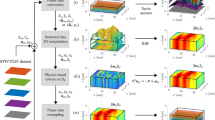Abstract
Volumetric velocity measurements taken in incompressible fluids are typically hindered by a nonzero divergence error due to experimental uncertainties. Here, we present a technique to minimize divergence error by employing continuity of mass as a constraint, with minimal change to the measured velocity field. The divergence correction scheme (DCS) is implemented using a constraint-based nonlinear optimization. An assessment of DCS is performed using direct numerical simulations (DNS) velocity fields with random noise added to emulate experimental uncertainties, together with a Tomographic particle image velocimetry data set measured in a channel flow facility at a matched Reynolds number to the DNS data (Re τ ≈ 937). Results indicate that the divergence of the corrected velocity fields is reduced to near zero, and a clear improvement is evident in flow statistics. In particular, significant improvements are observed for statistics computed using spatial gradients such as the velocity gradient tensor, enstrophy, and dissipation, where having zero divergence is most important.












Similar content being viewed by others
References
Adrian RJ, Westerweel J (2011) Particle image velcimetry. Cambridge University Press, Cambridge
Barnhart DH, Adrian RJ, Papen GC (1994) Phase-conjugate holographic system for high-resolution particle-image velocimetry. Appl Opt 33(30):7159–7170
Blackburn HM, Mansour NN, Cantwell BJ (1996) Topology of fine-scale motions in turbulent channel flow. J Fluid Mech 310:269–292
Bruun HH (1995) Hot-wire anemometry: principles and signal analysis. Oxford University Press, Oxford
Buxton O, Laizet S, Ganapathisubramani B (2011) The effects of resolution and noise on kinematic features of fine-scale turbulence. Exp Fluids 51:1417–1437
Chong MS, Perry AE, Cantwell BJ (1990) A general classification of three-dimensional flow fields. Phys Fluids A Dyn 2(5):765–777
Christensen K, Adrian RJ (2002) Measurement of instantaneous eulerian acceleration fields by particle image accelerometry: method and accuracy. Exp Fluids 33:759–769
Clark TH (2012) Measurement of three-dimensional coherent fluid structure in high Reynolds Number turbulent boundary layers, PhD thesis. Trinity Hall, Cambridge
de Silva CM, Baidya R, Khashehchi M, Marusic I (2012a) Assessment of tomographic PIV in wall-bounded turbulence using direct numerical simulation data. Exp Fluids 52(2):425–440
de Silva CM, Baidya R, Marusic I (2012b) Assesment of tomographic PIV using experimental and DNS data in turbulent channel flows. In: Proceedings of the 16th international symposium on applications of laser techniques to fluid mechanics. Lisbon, Portugal, 09–12 July
de Silva CM, Baidya R, Marusic I (2013) Enhancing Tomo-PIV reconstruction quality by reducing ghost particles. Meas Sci Tech 24(2):024010
del Alamo JC, Jimenez J, Zandonade P, Moser RD (2004) Scaling of the energy spectra of turbulent channels. J Fluid Mech 500:135–144
Elsinga GE, Scarano F, Wieneke B, van Oudheusden BW (2006) Tomographic particle image velocimetry. Exp Fluids 41:933–947
Foucaut JM, Stanislas M (2002) Some considerations on the accuracy and frequency response of some derivative filters applied to particle image velocimetry vector fields. Meas Sci Tech 13(7):1058
Ganapathisubramani B, Longmire EK, Marusic I, Pothos S (2005) Dual-plane piv technique to determine the complete velocity gradient tensor in a turbulent boundary layer. Exp Fluids 39:222–231
Klewicki JC, Murray JA, Falco RE (1994) Vortical motion contributions to stress transport in turbulent boundary layers. Phys Fluids 6(1):277–286
Maas H, Gruen A, Papantoniou D (2004) Particle tracking velocimetry in three-dimensional flows. Exp Fluids 15:133–146
Monty JP (2005) Developments in smooth wall turbulent duct flows. PhD thesis, The University of Melbourne, Parkville, VIC
Ng HC (2011) Experiments in smooth wall turbulent channel and pipe flows. PhD thesis, The University of Melbourne, Parkville, VIC
Ooi A, Martin J, Soria J, Chong MS (1999) A study of the evolution and characteristics of the invariants of the velocity-gradient tensor in isotropic turbulence. J Fluid Mech 381:141–174
Park SR, Wallace JM (1993) The influence of instantaneous velocity gradients on turbulence properties measured with multi-sensor hot-wire probes. Exp Fluids 16:17–26, ISSN 0723-4864
Tokgoz S, Elsinga GE, Delfos R, Westerweel J (2012) Spatial resolution and dissipation rate estimation in taylor–couette flow for tomographic piv. Exp Fluids 53(3):561–583
Vukoslavcevic P, Wallace JM, Balint J-L (1991) The velocity and vorticity vector fields of a turbulent boundary layer. Part 1. Simultaneous measurement by hot-wire anemometry. J Fluid Mech 228:25–51
Westerweel J, Scarano F (2005) Universal outlier detection for PIV data. Exp Fluids 39(6):1096–1100
Worth NA, Nickels TB, Swaminathan N (2010) A tomographic PIV resolution study based on homogeneous isotropic turbulence DNS data. Exp Fluids 49:637–656
Acknowledgments
The authors wish to gratefully thank Prof. R.D. Moser for making the Re τ = 934, DNS data available, and the financial support of the Australian Research Council. We would also like to thank Dr. Nicholas Hutchins for his help during the course of this study.
Author information
Authors and Affiliations
Corresponding author
Rights and permissions
About this article
Cite this article
de Silva, C.M., Philip, J. & Marusic, I. Minimization of divergence error in volumetric velocity measurements and implications for turbulence statistics. Exp Fluids 54, 1557 (2013). https://doi.org/10.1007/s00348-013-1557-8
Received:
Revised:
Accepted:
Published:
DOI: https://doi.org/10.1007/s00348-013-1557-8




